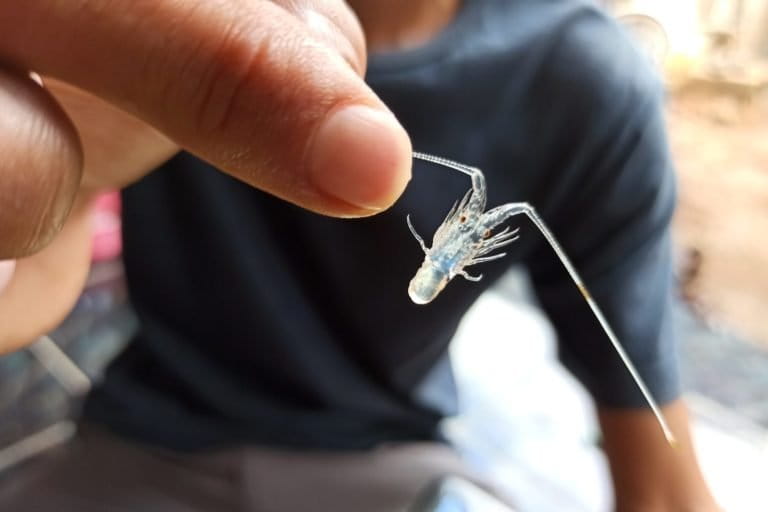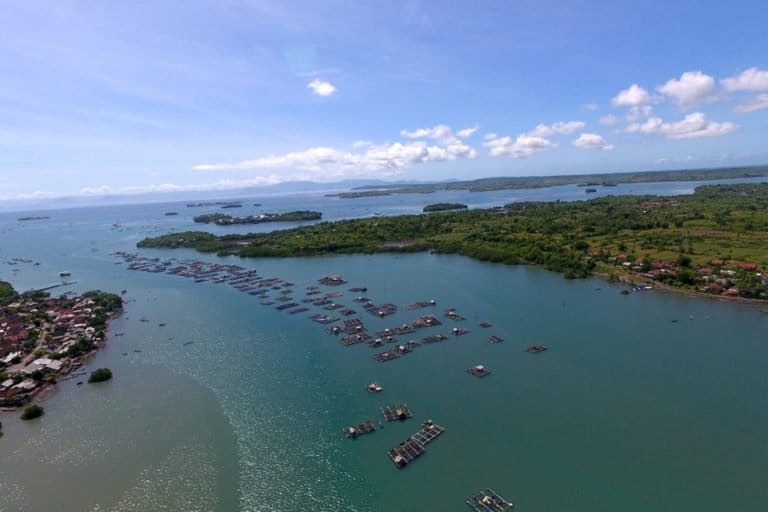- The resumption of Indonesia’s exports of wild-caught lobster larvae was supposed to be a golden opportunity for the country’s small fishers, who had been hit by an export ban imposed in 2016.
- Part of the requirements for lifting the ban was that exporting companies would partner with small fishers to set up lobster farms.
- However, this hasn’t happened, with exporters bypassing the requirement by buying directly from the fishers — in some cases not paying in full — and not investing in aquaculture farms.
- Many of the exporting companies are linked to politically influential figures, with at least one hiring a convicted lobster smuggler as a consultant.
LOMBOK, Indonesia — Jafarudin, a fisherman from Indonesia’s Lombok Island, had been looking forward to the resumption of baby lobster exports. Months before the Indonesian fisheries ministry made an official announcement in May lifting a ban imposed in 2016, Jafarudin and many others had started making custom nets to catch these highly valuable larvae.
The fisheries minister, Edhy Prabowo, had visited a fishing community along the eastern coast of Lombok in December 2019, and prospects looked bright for the thousands of fishers here, many of them opposed to the ban. That regulation was issued by Edhy’s predecessor, Susi Pudjiastuti, in an effort to protect dwindling populations of wild lobsters and crack down on the illegal trade in the larvae.
With the ban in place, fishers like Jafarudin had to switch jobs because they didn’t have the money to invest in new equipment for other types of fishing or aquaculture. Under Edhy, however, small fishers are guaranteed an opportunity to supply lobster larvae to exporters. The lifting of the ban also requires fisheries companies to work with small fishers to develop the lobster aquaculture sector.
Floating cages equipped with the custom nets to capture lobster larvae have sprung up along the eastern and southern coasts of Lombok. The island, part of the Lesser Sunda archipelago that’s renowned for its marine biodiversity, has many narrow bays that are perfect for cultivating baby lobsters in.
“I can go out fishing every day,” Jafarudin told a visiting Mongabay Indonesia journalist on July 26.


But in the months following the lifting of the lobster larvae export ban, reports have emerged indicating newly licensed exporters are abusing loopholes in the new policy and cutting out small fishers entirely.
Within less than two months of exports resuming, the fisheries ministry had granted export permits to 31 of the 100 companies that applied for them. Exporters are required to demonstrate a “sustainable harvest” from their existing lobster farms before they can ship out the wild-caught larvae and also have to release 2% of their harvest back into the wild.
Experts calculate that in meeting those requirements, the first exports out of Indonesia should only have been possible early next year at the soonest. Yet by June, a month after the ban was lifted, exports were already underway.
One of these newly licensed exporters is PT Nusa Tenggara Budidaya, which in July appeared to have met one of the requirements by releasing 200 farm-cultivated lobsters into the wild. But an investigation by Mongabay Indonesia found that the lobsters did not come from any of the company’s farms. Instead, they were supplied by a Lombok fisherman, Nasrullah, who also serves as the secretary for fishing cooperatives Koperasi Laut Lombok Bersinar and Koperasi Laut Lombok Gemilang. He told Mongabay he had had raised the lobsters in his own floating cages before PT Nusa Tenggara Budidaya was licensed to export lobster larvae.
The company still hasn’t paid him for some of the lobsters, Nasrullah added.
He said PT Nusa Tenggara Budidaya was one of several exporting companies that had approached local fishing cooperatives in a bid to get around the new requirements. At the same time, small fishers are joining these cooperatives to get permits to harvest wild lobster larvae. In West Nusa Tenggara province, of which Lombok is a part, more than 1,000 fishers have been granted capture permits since the export ban was lifted.
Like many of the other newly licensed exporters, PT Nusa Tenggara Budidaya is closely linked to influential political figures. Fahri Hamzah, a former deputy speaker of the Indonesian parliament, is a part-owner of the company. One of its business consultants is Mahnan Rasuli, a village chief in Lombok who in 2018 was convicted and sentenced to two years and eight months in jail for illegally exporting lobster larvae.
The West Nusa Tenggara provincial fisheries agency says it’s having difficulty monitoring the lobster larvae exporters, given that most of these companies are based outside the province. It says it hasn’t granted aquaculture permits to any of the companies, which they would need if they were legitimately setting up lobster farms in the province as part of the requirements to be allowed to start exporting larvae. Provincial authorities are also drafting regulations to push the development of lobster aquaculture by exporters and small fishers.


Marine observers say the exporters are abusing the new export regulation. “This can be considered illegal, unreported and unregulated fishing, or an illegitimate fisheries practice,” Habiburrohman, chair of the Indonesia Lobster Association (ILA), told Mongabay on Aug. 8.
A separate investigation by newsmagazine Tempo highlighted another potential violation by another of the newly licensed exporters, PT Royal Samudera Nusantara. The company in June attempted to export a batch of lobster larvae to Vietnam, but missed the chartered flight out. According to Tempo, the failed attempt would have been the company’s second exported batch since the ban was lifted in May.
Conservationists and policymakers consider illegal exports of lobster larvae a major threat to the wild populations. The fisheries ministry puts the latest estimate of potential wild lobster stock in Indonesian waters at 27 billion. But the National Commission for Fisheries Resources Research (Komnas Kajiskan) reported in 2016 that lobsters in six out of 11 fisheries management areas in Indonesia were overfished, while the rest were being harvested at maximum capacity.
The ministry currently allows the wild harvesting of nearly 140 million lobster larvae: 70% is allocated for domestic cultivation in aquaculture farms, while the rest are for export.
Lobsters are among Indonesia’s top fisheries commodities, but the illegal export of larvae cost the country 900 billion rupiah ($62 million) in lost revenue in 2019 alone, according to the PPATK, the government’s anti-money-laundering watchdog. The larvae are typically sold to buyers in Vietnam, Singapore and China, where they can be raised and sold when mature at much higher prices.
But fisheries experts and conservationists say the quota and requirements will not be enough to spur companies into investing in Indonesia’s lobster aquaculture sector, or to stop illegal lobster exports.
Habiburrohman called for an independent audit of the licensed exporters, and for a halt to larvae exports until the companies have demonstrated they can successfully cultivate lobsters without any shortcuts.
“ILA also urges the government and authorities to strictly enforce the law against individual or any company exporting lobster larvae who’s committing illegal fishing practices,” he said.
This story was first reported by Mongabay’s Indonesia team and published here and here on our Indonesian site on Aug. 31 and Sept. 1, 2020.
FEEDBACK: Use this form to send a message to the author of this post. If you want to post a public comment, you can do that at the bottom of the page.